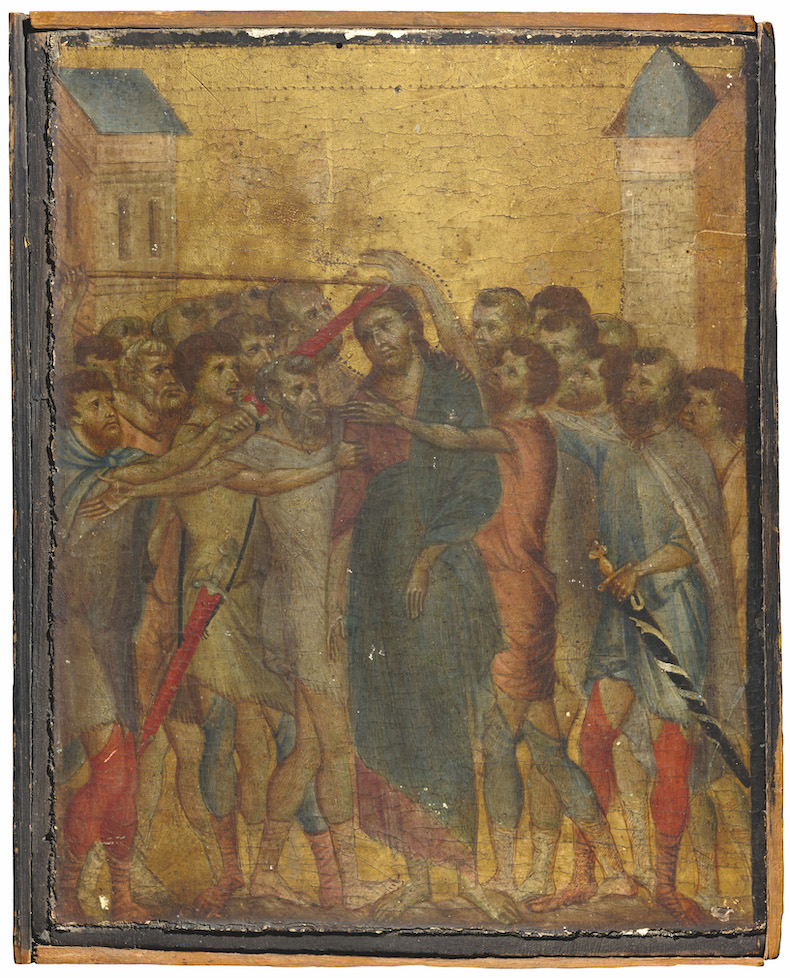Musée du Louvre, Paris
The Mocking of Christ, c. 1280, Cimabue
Any rediscovery of an exceptional work of art is important. When that work is by an artist of great rarity and profound significance to the history of Western art, a great museum must do its utmost to ensure it is placed on public display. The Musée du Louvre’s acquisition of The Mocking of Christ, by the 13th-century Florentine master known as Cimabue, was a four-year marathon. Found hanging above a kitchen stove in Compiègne, north of Paris, this small panel was initially lost to the museum when the institution was outbid at auction in October 2019. After it was declared a national treasure and its export blocked by the French ministry of culture, the Louvre faced the not inconsiderable challenge of raising €24m to match its purchase price.
Only around a dozen works securely attributed to Cimabue are known. These include mosaics as well as crucifixes, frescoes and panels painted in egg tempera. Of these panel paintings, most – three or four – are of an enthroned Madonna and Child of the Maestà type. This makes a narrative painting all the more precious, revealing the artist’s contribution to the development of narrative devotional painting.
Vasari, two centuries later, effectively proclaimed Cimabue the founding father of Western art – the historian’s famous Lives of the Artists begins with him. But in his own time, the consensus was different. ‘Cimabue thought to hold the field of painting; and now Giotto’s name is on everyone’s lips,’ is how Dante put it. Modern scholars have also questioned the historical importance Vasari assigned to him, and few have been brave enough to focus on an artist so poorly documented as well as represented. This lack of scholarship partly explains how three panels – The Mocking of Christ being one – dismembered from a diptych depicting the Passion of Christ were only recently identified.
Another, The Flagellation of Christ, had been hiding in plain sight. Acquired from the Knoedler Gallery in Paris by the Frick Collection in New York in 1950, it had initially been attributed to the Sienese artist Duccio, who may have worked alongside Cimabue. The third, the Virgin and Child with Two Angels, was discovered in a country house in Suffolk in 2000. It was withdrawn from auction to be accepted in lieu of tax and allocated to the National Gallery in London. All are of approximately the same dimensions. The wood grain in the poplar panels of at least the latter two paintings is continuous – as are the wormholes. They all share underdrawing in the same style and the same craquelure on the paint surface. It has been proposed that they date to around 1280 and belong to the left-hand wing of a diptych comprising four panels each side.
The previous owner of The Mocking of Christ believed, not unreasonably, that it was an icon. Certainly, Cimabue was influenced by contemporary Byzantine painting. The standing (rather than seated), blindfolded Christ looks to Byzantine precedents, as do the figure on the far left striking Christ with a long reed and the outstretched arm about to deliver a mighty slap. In this panel, however, unlike any known other, Cimabue has created a crowd, come to torment Christ prior to his crucifixion. One person even appears to be attempting to remove his halo. This massing of interwoven figures, their range of facial expressions and exchanged glances adding to the story and the emotion of the scene, is testimony to a dramatic sense and a naturalism that were to prove so influential to the subsequent generation. The diagonals of swords and arms focus our attention upwards onto the central figure of the Passion, the passive, suffering Christ. The Mocking of Christ joins Cimabue’s Maestà in the Louvre, and both will be the focus of an exhibition in the new year (22 January–12 May 2025).

The Mocking of Christ (c. 1280), Cimabue. Photo: Hervé Lewandowski; © Musée du Louvre














![Masterpiece [Re]discovery 2022. Photo: Ben Fisher Photography, courtesy of Masterpiece London](http://zephr.apollo-magazine.com/wp-content/uploads/2022/07/MPL2022_4263.jpg)
‘Like landscape, his objects seem to breathe’: Gordon Baldwin (1932–2025)